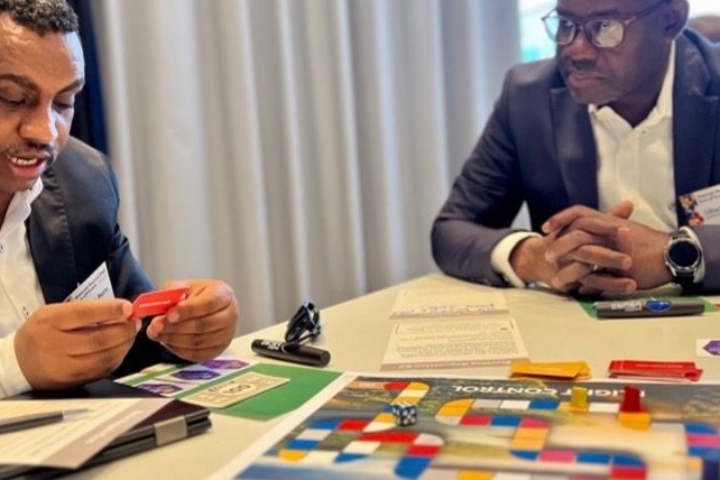Azurit Foundation’s 2022 Review
Welcome to Azurit Foundation’s first annual review. We’ll begin our annual reporting with a blog version and will build on it in the coming years. Thank you for taking an interest, and we would be thrilled to hear your thoughts and feedback.
Thank you,
Anton, Gregor, Josephine & Lea
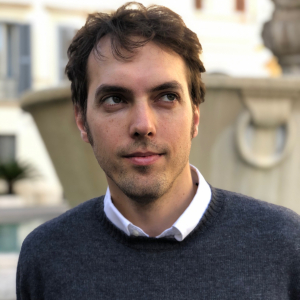
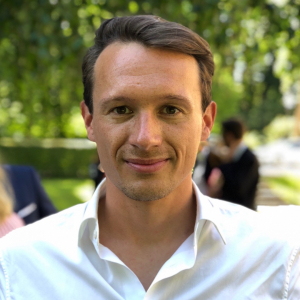
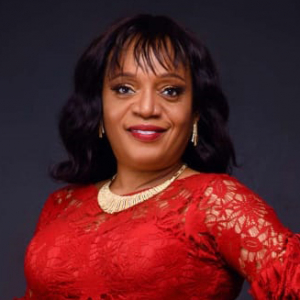

1. Introduction
2022 marked the first full year in which Azurit Foundation was operational. We began in mid-2021 by developing the core elements of our approach. 2022 was all about bringing this approach to life by testing and refining it. We made our first grants (yay!) and obviously we also developed all the nitty-gritty of our grants management: from sourcing via selecting via reporting to building the actual partnerships with our grantees. Additionally, we launched our website, started a blog, and spent quite a lot of time building our network. Another highlight was the addition of Josephine to our advisory board in 2022!
2. Activities
We screened 106 organizations and finalized 11 grants across the following grant categories:

You will find 6 out of these 11 grants here. Two of the 11 grants are rapid response grants for Ukraine (Krisenchat & Alliance4Ukraine), and in three of the 11 grants we provided co-funding to grant-making partners/intermediaries: Acumen, Ashoka, and D-Prize.
Our goal is to support locally-led organizations from low-income countries that work with a strong evidence focus. Statistically, local leaders are far less likely to access funding despite being in the best position to understand and respond to local needs and opportunities. We believe that localization plays a central role in strengthening justice globally AND building effective mechanisms.
As 24 out of 28 low-income countries are in Africa, our grantmaking focuses on the African continent. In 2022, our portfolio consists of the following composition:
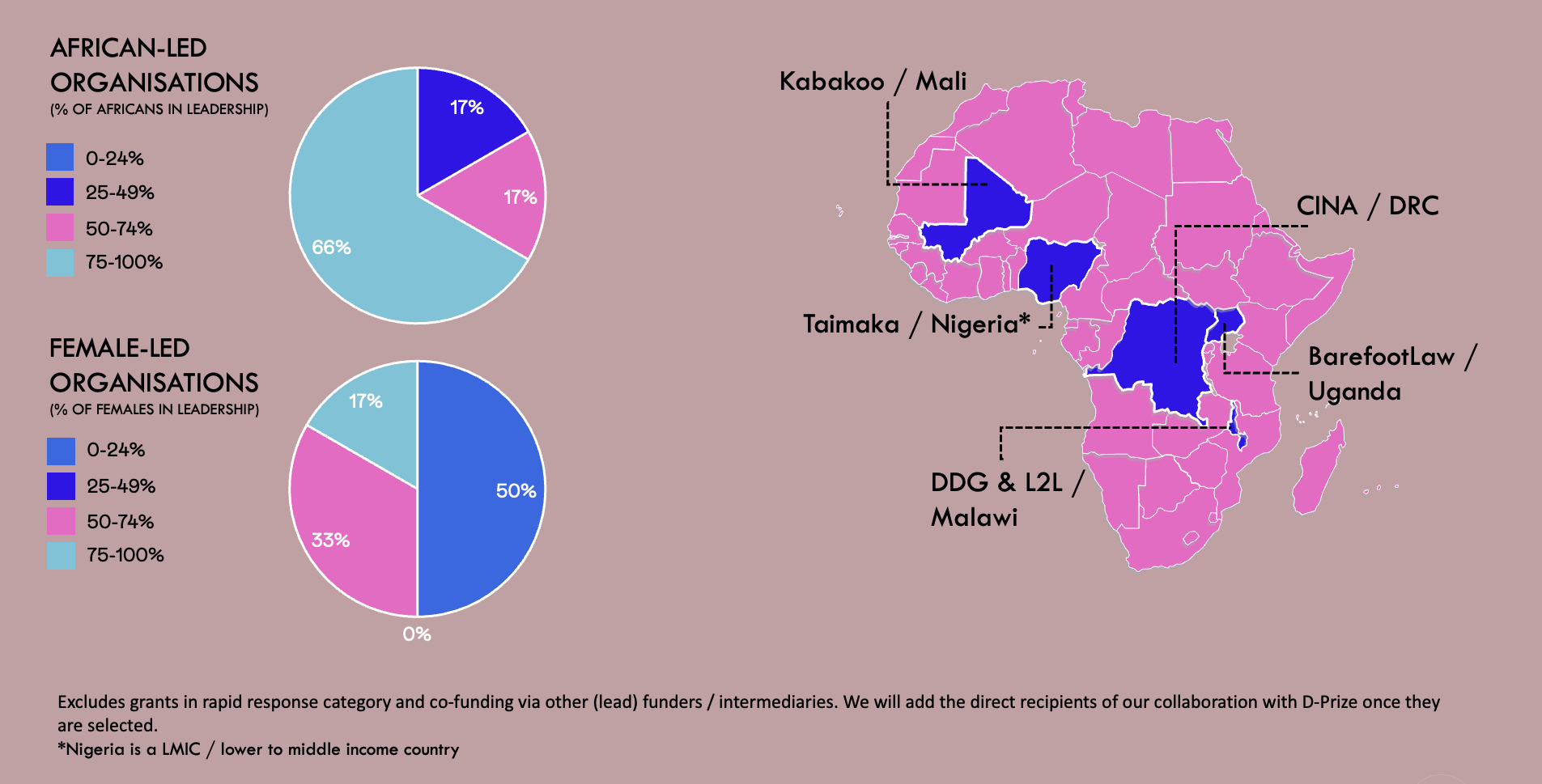
2.1 How we work
Broadly speaking, our grants management is currently divided into two main phases:
- Prior to funding commitment: This includes our sourcing, due diligence, and legal considerations
- After funding commitment: This includes non-financial support, mutual learning, reporting and strengthening our partnerships
As a new organisation, we were in the beautiful but also sometimes challenging position of having to develop everything from scratch. We are deeply grateful to all the organisations out there who kindly shared their experiences, templates and recommendations with us. We spoke to more than 90 experts from NPOs, grantmaking, impact investing, and research in 2022 who helped us shape our work. Let’s take a quick tour of what we set up in the last year:
Prior to funding commitment
How we source
At the moment, we don’t have the capacity for open calls or unsolicited grant requests. We proactively look for partners ourselves. There are pros and cons to this approach. Open calls can be very time-consuming and frustrating for all involved, yet they can also broaden the perspectives and provide access to funding for those who are not yet on the radar.
Based on our criteria we scan relevant publications and ask intermediaries, experts and other funders for their recommendations. Many kindly shared (pipeline) candidates with us. Particularly interesting are strong candidates that might be too early-stage for others or not within their focus areas. The good thing about our approach is that it is collaborative and might reduce duplication. Our additionality (on the level organisation level) is likely lower when we fund those that have already been funded by others. However, the additionality on the societal level – or at least our contribution – might be even higher if we support organizations that have passed various quality checks.
How we select
Our due diligence (DD) process is quite detailed. It includes a document review, several calls with the organisation as well as stakeholders and experts in the relevant fields. The general idea is to really get to know each other. Since our funding is unrestricted and trust-based, the selection process is crucial.
- Building trust takes time, and it’s our responsibility to create an environment that fosters openness. However, it takes less time to gauge the general stance of potential partners towards transparency and their interest in building relationships that allow for mutual learning.
- We fund evidence-driven approaches. We look at evidence and impact on the grantee level, so we don’t impose standardised impact KPIs or prescribe how evidence should be collected. This means we try to dive deeply into understanding how our partners define and assess their impact. Our partners typically have a strong intrinsic motivation to do so and have set up their M&E systems early on. During our DD, we seek to understand not only the general frameworks but also how these are implemented and feed into general operations and strategy development.
- As we provide unrestricted support our grantees currently don’t have to write grant proposals. Yet we take an even deeper look at strategic objectives and milestones that our partners have in place (prior to receiving funding from us). Our criteria may sometimes conflict, such as balancing the willingness to remain true to one’s mission while remaining open to innovation. Through our due diligence process, we actively seek partners who exhibit clarity on how findings inform strategy decisions and balance following new opportunities without losing focus.

After funding commitment
Partnership approach
We believe that our partners are best placed to determine their needs, so our funding is unrestricted. We asked our grantees about their experience with us anonymously. 100% responded. Given the small sample size (7), these findings are far from being statistically valid. Nonetheless, our partnership approach seems to be off to a good start:

We were surprised to learn that our partners rated their experience prior to receiving funding positively. Since we developed our processes on the go, we expected more delays and ambiguity.
Our grantees reported leveraging almost 500k EUR through our support in 2022, which is great and demonstrates the importance (and effectiveness) of providing unrestricted funding to the right partners.
Reporting
Our reporting approach aligns with our overall objective of focusing on learning and building partnerships that foster openness. We developed our Oral Reporting approach as a result of this goal. We focus on semi-structured conversations that are well-documented, rather than lengthy written reports. In our experience, conversations are less time-consuming for our grantees and make it easier to discuss the topics that matter (German speakers can find more details here). We collaborated with the Swiss SKKG and German Unternehmerstiftung für Chancengerechtigkeit to develop our reporting approach. We like the fact that 3 foundations from diverse fields were able to find common ground, which demonstrates how broadly some approaches can be implemented, as long as values are aligned.
3. Some of our grants
Almost all grants that are part of our strategic portfolio are portrayed here. For this report, we have chosen to focus on three organisations that exemplify our foundation’s mission and values.
Kabakoo Academies, Mali
Kabakoo was our first grantee. Kabakoo is a community-driven upskilling platform designed to allow young people in West Africa to develop the mindset and the skills needed to improve their life in a context of missing formal jobs. It does so with a modern pedagogy that blends high tech and indigenous knowledge. Collaborative project-based experiences rooted in the realities of learners are the cornerstone of the learning process. Kabakoo has a strong mission and from day 1, systemically wanted to understand what works and how they can constantly pivot their approach. Since 2022, they are running an RCT to understand this even better and contribute to research on lifelong learning in Africa and beyond. There is a lot of innovation in Kabakoo’s work but it is also evidence-based (on a conceptual AND operational level).
Kabakoo has been a great partner, helping us to reflect on our work and to identify blind spots by asking important questions. We also ran a workshop during the German Foundations Days together in September and have been able to connect Kabakoo to other funders (who decided to fund Kabakoo).
D-Prize, USA
D-Prize is not our typical grantee but a collaboration partner to whom we provided co-funding in 2022. D-Prize and Azurit have a strong overlap in their approach. D-Prize’s mission is to scale access to evidence-based poverty interventions through seed awards to new ventures. Many solutions to poverty already exist. The challenge is distributing them to the people who need them most. Their marginal impact comes from funding very early-stage pilots and thereby helping new leaders build organisations that otherwise might not find support. 80% of ventures they award have raised less than 5k USD when they partner, and 90% are locally-led. We met through Taimaka, another grantee of us who also received funding from D-Prize.
In 2022, D-Prize developed a new program to strengthen their post-pilot support for partners who show strong operational results but struggle on the fundraising level. They will test different offers like fundraising trainings and extended seed awards in various combinations and compare the outcomes via A/B testing. The primary objective is learning-focused, and we look forward to sharing the early results in 2024.
Ladder to Learning, Malawi
We started by telling you about our first grant in 2022 and now we end with the latest – we finalised it a few days before Christmas. Ladder to Learning is a female-, youth- and locally-led organisation that focuses on literacy in public schools in Malawi. They employ the “Teaching at the Right Level” (TaRL) approach, a well-researched and cost-effective solution. With about $50,000 their Literacy Hubs were able to provide educational resource access and programs to over 10,000 students in the 2022 academic year. 72% of the students in their core reading program transitioned to the next reading level in 2022. The drop-out rates for their voluntary offers are close to zero. This is possible through a strong network of dedicated local volunteers that look out for their students.
We met Ladder to Learning through Segal Family Foundation, another values-aligned funder. We look forward to getting to know the Ladder to Learning team even better in 2023, and partnering with them beyond financial support.
We are proud to support all organisations in our portfolio. Their work is inspiring, and we remain committed to building meaningful partnerships with them and learning from their successes and challenges.
4. Some things we have learned
As we have written extensively about the importance of learning, we would like to share a few insights with you. While we cannot cover all of them due to space limitations, we are more than happy to discuss them in greater detail with anyone who is interested.
A focus on evidence-driven solutions does not equate to an inflexible focus on metrics:
While we appreciate data-driven approaches, it is not solely about numbers. It involves interpreting data and considering aspects that cannot be measured. If we take evidence seriously, we must also be willing to admit when something is not working and be open to change. Taimaka’s decision document is a great example of this, outlining a fundamental focus area change from post-harvest loans to malnutrition in 2022. They made this change in a deliberate manner, based on their general mission and, of course, evidence. Funders should enable and not impede such flexibility.
Unrestricted funding is crucial:
Let’s be honest, we are generalists, not sector or country experts. Our assumption was, and still is, that unrestricted funding is more effective in that context. It’s great to see this translated into numbers. With the help of our funding, three of our grantees have been able to leverage more than 200% of the amount we provided to them (almost 500k EUR in total). They didn’t even need us in person for that but mainly the flexibility of our funding. Unrestricted funding necessitates a strong belief in our partner, which is why we take the selection so seriously and focus on establishing strong relationships. This seems to work better for risk mitigation than an excessively controlling approach.
Reality check on non-financial support:
This is for a number of reasons: limited human resources with only one employee, and the belief that we should not be too pushy with non-financial support as the line between helpful and intrusive can be fine. Instead, we focused on building relationships and assumed that this would lead to non-financial support, if our partners desired it. The findings from our 2022 survey did not confirm this assumption:
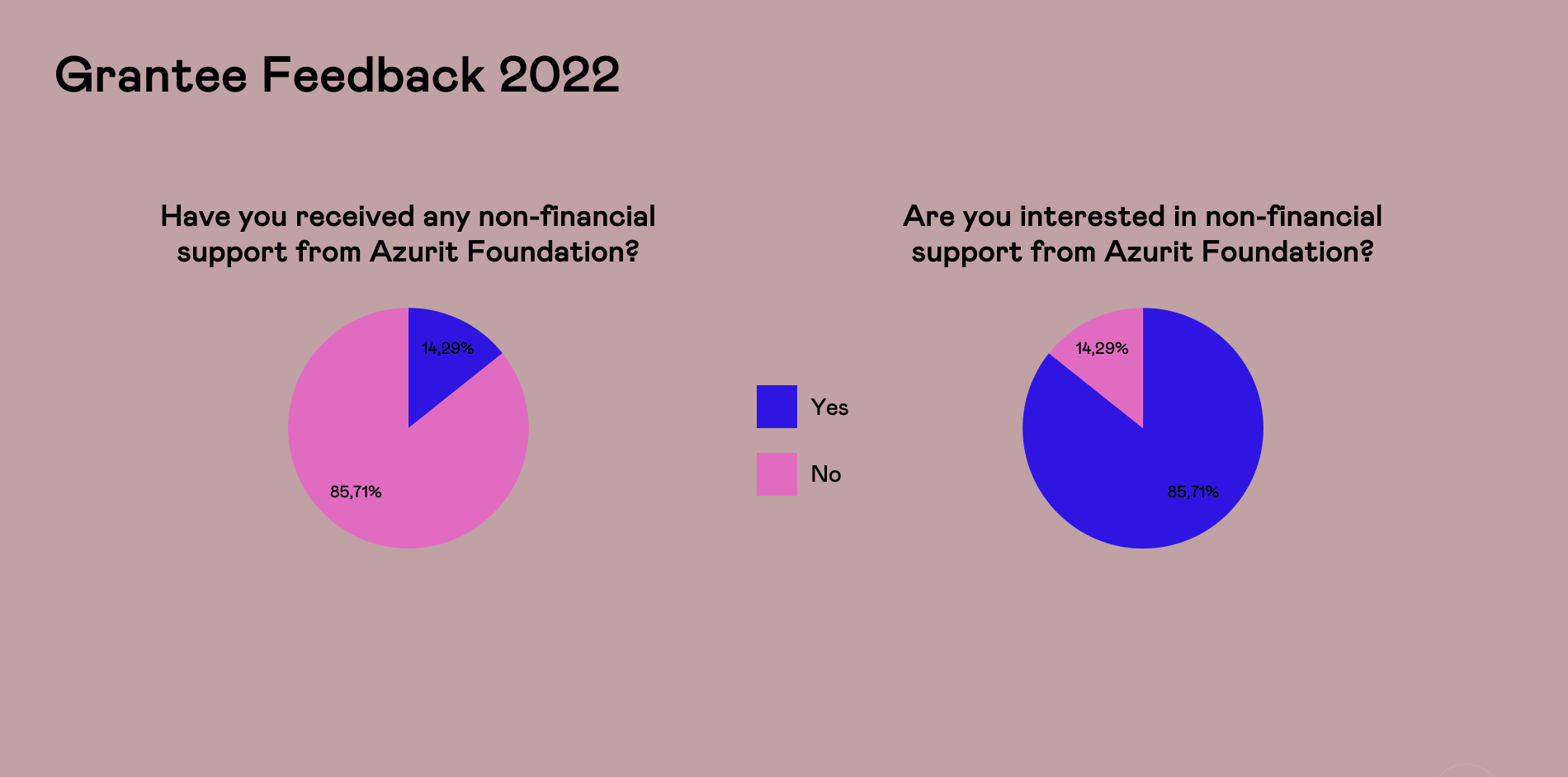
Firstly, it is noteworthy that we expected a higher number of “yes” answers for the first question. While our grantees seem to value the overall experience (see above) and rate the partnership level very positively (see below), this does not necessarily equate to non-financial support. Secondly, our vagueness led to confusion. What qualifies as non-financial support, and what types of support are available? Our idea to wait for a pull instead of a push did not work out well, and in the future, we will need to better explain what we can (and cannot) offer.
Hello, here we are – how to better communicate our work:
Our partners see the most significant room for improvement in the area of “external communication”. We understand this. Since Azurit Foundation is new, it is not yet well-known and has had limited public exposure and activities. From the feedback we received, we also learned that our partners are interested in expanding their network and connecting with other funders. For both, external communication is crucial.

We also see room for improving how we communicate our strategy. Not all our grantees fully understand our approach and these are partners who we work with. While we have developed our strategy throughout the year and continue to work on refining our narrative, we also need to consider channels and reach. Even the most well-crafted strategy will not be effective if it is not known…
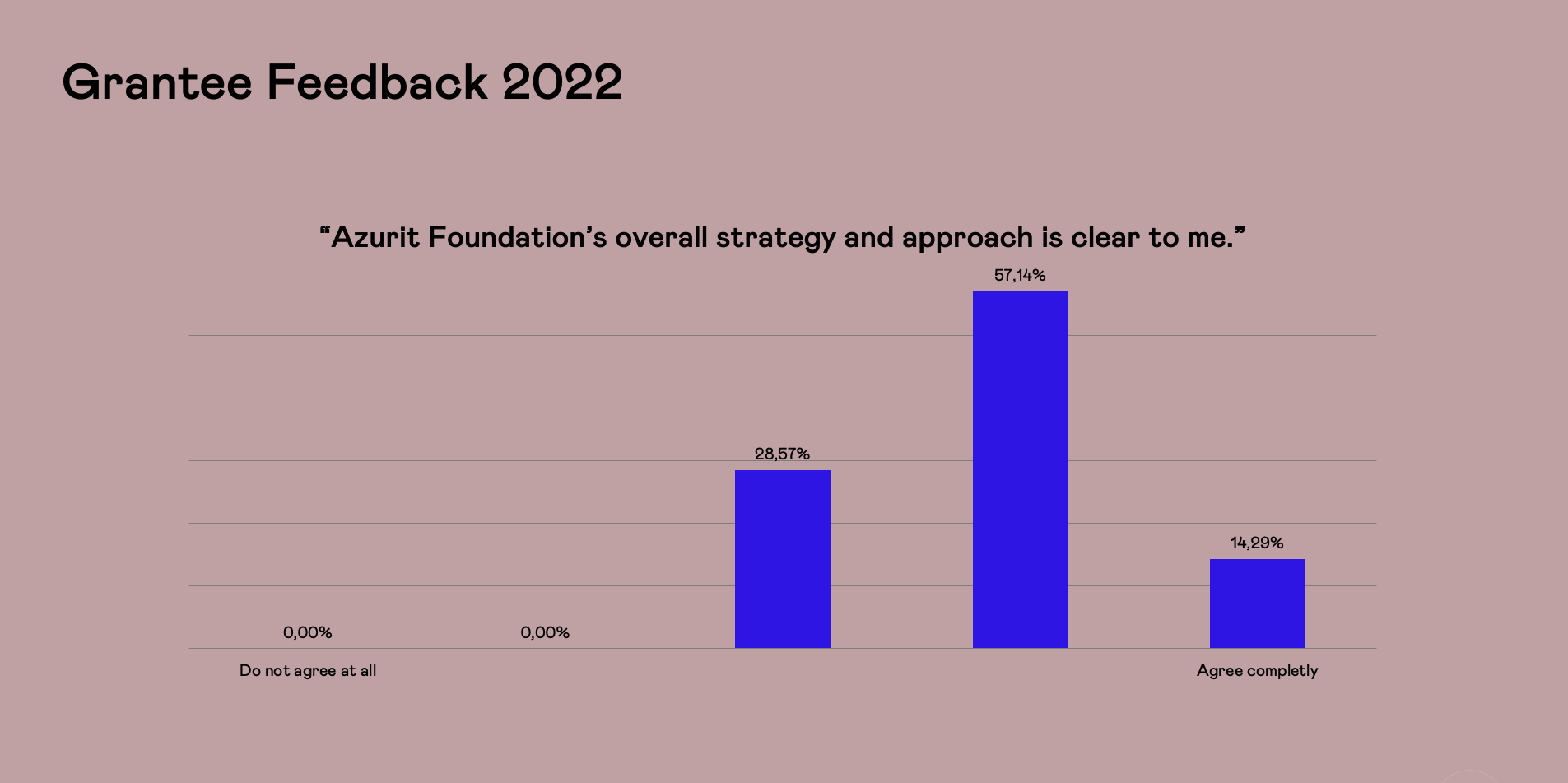
Aligning philanthropy and investment strategy
As many of you know, we are not just philanthropists but also impact investors. Aligning these two fields was an important topic for us in 2022.
Learning 1: a fully integrated approach is not (yet) realistic
By “fully integrated” we refer to the textbook venture philanthropy model of first identifying robust partners and subsequently determining the most suitable financing tool or transitioning partners from grants to investments along a funding continuum. On the philanthropic side, we embrace high levels of risk and concentrate solely on social impact. Finding a shared risk profile can be challenging. Our philanthropic endeavors often target regions that are not conducive to investment, and even when that is not the case, our capacity to manage direct investments in these geographies is limited. Furthermore, there is often a complementary aspect – especially our focus on “knowledge” may not always have a distinct business case, but that does not diminish its importance.
Learning 2: mission-aligned strategies work well (so far)
While a fully integrated approach encounters certain obstacles, aligning our investment strategy with our overarching mission has been quite successful: supporting local, high-impact ventures on the continent. There is no shortage of outstanding entrepreneurs and promising opportunities to invest in the burgeoning African market, enabling leapfrogging and local value creation. Our focus on investment funds that are aligned with our philanthropic mission allows us to learn and contribute to market building. The future of this journey is uncertain, but we are clearly optimistic and enjoy the ride so far!
5. Outlook
Our future is exciting, so here are a few of our 50 milestones for this year:
- Exits: We haven’t had an exit yet. So it’s time to take a closer look and define not just our decision-making criteria, but also how we handle this in practice.
- Reach our portfolio targets for new grants in 2023: All new grants in 2023 are supposed to go to African-led and at least 50% to female-led organizations
- Narrowing down: We are working to sharpen our focus and strategically concentrate our resources. We will do this step-by-step as we also want to remain flexible and allow for exploration.
- Enhancing decision-making and strengthening diversity: While retaining our advisory board’s role in grant decisions, we plan to expand its membership and promote diversity within our organization. Additionally, we aim to establish lean expert networks to more systematically assist in the sourcing and assessment of grantees, refining our processes for even greater impact.
- Venturing into fundraising: To broaden our reach and amplify our influence, we will begin exploring opportunities to engage additional supporters. This will enable us to extend our impact and forge stronger partnerships in the pursuit of our mission.

